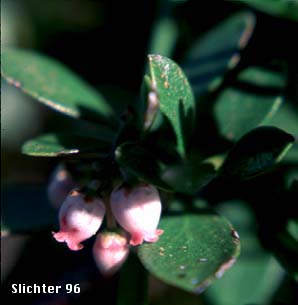Pinemat manzanita is an attractive, prostrate subshrub with long, creeping stems which may often be partly buried. Much branched from the base, the stems often root at the nodes with contact with the ground. Plants form mats up to a meter or so wide and have short, stiff, smaller branches that ascend up to 30 cm high. The bark on older stems is glabrous, reddish brown and may exfoliate to some extent while that of the younger stems may bear some hairs. The leaves are short-petioled and oblanceolate to obovate in outline with wedge-shaped bases. The tips are rounded to acute with a short, sharp tip. The blades are 15-25 mm long and glabrous or with some hairs along the midrib.
The inflorescence consists of close racemes of 3-8 flowers on glabrous, short pedicels from 2-4 mm long. The corolla is white or pinkish. The fruit is a globose, light red to brownish berry from 5-8 mm wide.
The similar Arctostaphylos uva-ursi is found at lower altitudes in the mountains and has leaves with a rounded tips rather than a short, sharp tip. Its berry is bright red and the upper leaf surface is darker green than the lighter lower surface.
Both plants are attractive, low maintenance ground covers for sunny areas which are easily obtainable from many commercial nurseries.
Pinemat manzanita may be found in clearings or open conifer woods, most typically at moderate to high elevations in the mountains.
Pinemat manzanita may be found from Washington south through the Cascade Mts. into Oregon whence it is found towards the coast in Curry County and further south through the Sierra Nevada of California. It is found east to the Blue Mts. of central and northeastern Oregon as well as southeastern Washington.
